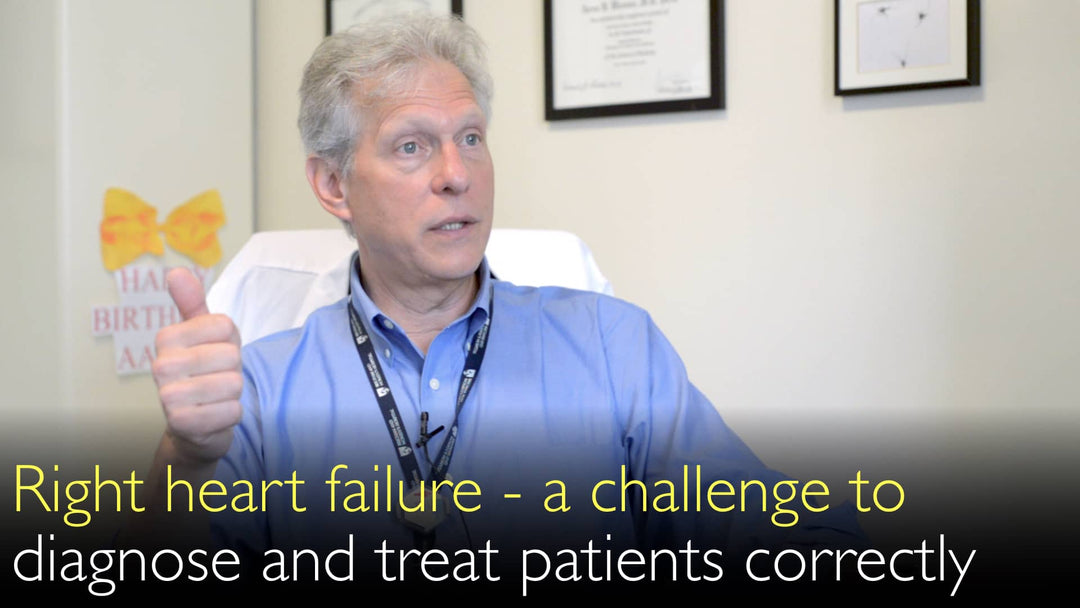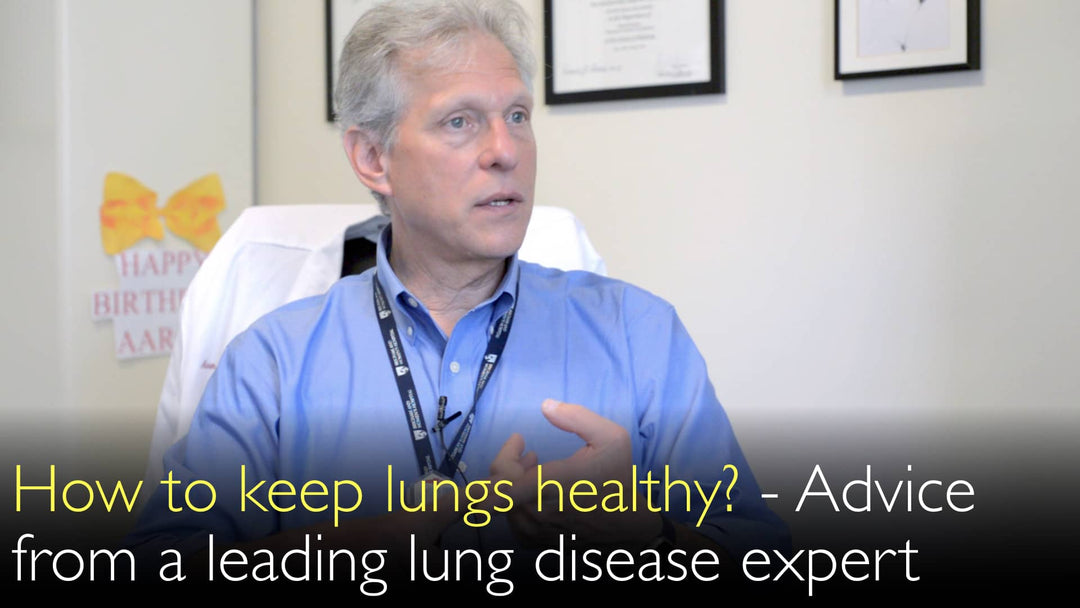Leading expert in pulmonary vascular disease and right heart failure, Dr. Aaron Waxman, MD, explains the complexities of right ventricular dysfunction. He details how right-sided heart failure often stems from pulmonary hypertension or left heart failure. Dr. Waxman describes the unique anatomy and physiology of the right ventricle that makes it vulnerable. Diagnosis requires advanced imaging like cardiac MRI and right heart catheterization. Current treatments focus on the underlying cause, as targeted therapies for the right ventricle itself are a major unmet need.
Diagnosis and Treatment of Right-Sided Heart Failure
Jump To Section
- Understanding Right Heart Failure
- Causes of Right Ventricular Failure
- Right Ventricle Anatomy & Physiology
- Symptoms of Right Heart Failure
- Diagnosing Right Ventricular Failure
- Treatment Options Right Heart Failure
- Full Transcript
Understanding Right Heart Failure
Right-sided heart failure is a critical condition where the right ventricle cannot pump blood effectively to the lungs. Dr. Aaron Waxman, MD, describes it as a continuum of dysfunction within the entire right-sided heart system. This system includes the right ventricle, right atrium, systemic veins, and the pulmonary vascular network. Patients often present with classic symptoms like shortness of breath and ankle swelling, signaling the heart's impaired function.
Causes of Right Ventricular Failure
The most common cause of right ventricular failure is actually left-sided heart failure. Dr. Aaron Waxman, MD, explains that elevated pressures in the left heart backfill into the pulmonary circulation. This increased pressure ultimately strains the right side of the heart. Dr. Aaron Waxman, MD, also focuses on primary pulmonary vascular diseases, such as pulmonary arterial hypertension (PAH). In PAH, the lung's blood vessels become stiff and rigid, forcing the right ventricle to work against much higher resistance.
Right Ventricle Anatomy & Physiology
The right ventricle has a unique and complex structure that differs significantly from the left ventricle. Dr. Aaron Waxman, MD, notes its distinctive U-shape, which guides its peristaltic-like, wave-like contraction pattern. It is a thin-walled chamber designed for a low-pressure, high-compliance system. In disease states, this compliance decreases and resistance increases, placing the muscle at a mechanical disadvantage. This leads to right ventricular dilation, fibrosis, and a progressive loss of contractile effectiveness.
Symptoms of Right Heart Failure
The symptoms of right heart failure are directly related to fluid accumulation and poor cardiac output. Dr. Aaron Waxman, MD, states that patients typically experience progressive shortness of breath. Fluid retention, or edema, is a hallmark sign. This often begins as swelling in the lower extremities. As the condition worsens, fluid can accumulate in the abdomen, a condition known as ascites. These symptoms indicate worsening right ventricular dysfunction and heart failure.
Diagnosing Right Ventricular Failure
Accurate diagnosis of right ventricular failure requires a multi-modal approach. Dr. Anton Titov, MD, and Dr. Aaron Waxman, MD, discuss the limitations of echocardiography, as it cannot always visualize the entire right ventricle. The best way to assess right ventricular structure and function is with cardiac MRI. Right heart catheterization is essential for obtaining direct pressure measurements within the heart and pulmonary arteries. This invasive test provides critical data to guide treatment decisions.
Treatment Options for Right Heart Failure
Treating right heart failure remains a significant clinical challenge. Dr. Aaron Waxman, MD, emphasizes that there is no specific medication designed solely for the failing right ventricle. Current therapy focuses on treating the underlying cause, such using pulmonary vasodilators for pulmonary hypertension. Medications proven for left heart failure, like certain stimulants, are often used but are much less effective for the right side. Dr. Waxman identifies the development of targeted right ventricular therapies as a major unmet need in cardiovascular medicine.
Full Transcript
Right heart failure can manifest with shortness of breath and ankle swelling. Heart MRI can help to diagnose right heart failure.
Dr. Anton Titov, MD: What is right-sided heart failure?
Dr. Anton Titov, MD: Why has right-sided heart failure attracted less attention previously?
It is a cause of heart failure that is very important to determine.
Dr. Anton Titov, MD: How do you find appropriate treatment for right ventricular heart failure?
Dr. Aaron Waxman, MD: Right ventricular heart failure is a continuum of dysfunction of the right ventricle. We think the right-sided ventricle is part of the right-sided heart system. It includes the pulmonary vascular network, both the pre-capillary and post-capillary pulmonary vascular network.
Dr. Aaron Waxman, MD: The right-sided heart system also includes the right atrium and the systemic veins draining into the right heart. The most common cause of right-sided heart failure is left-sided heart failure. Pressures rise in the left heart, then backfill into the lung and ultimately affect the right-sided heart.
Dr. Aaron Waxman, MD: We focus on the pulmonary vascular diseases. The primary dysfunction is in the blood vessels of the lung, such as pulmonary arterial hypertension. Lung blood vessels become stiffer and more rigid, which causes a backfill of pressure and volume into the right heart.
Dr. Aaron Waxman, MD: The right heart ventricle is a muscle, but it is much more complex than the left heart. Because the right ventricle of the heart has a U-shape to its inflow-outflow tract, it changes its contractility from the beginning of heart muscle contraction. The right ventricle also has a much lower pressure and operates in a lower resistance–high compliance system.
Dr. Aaron Waxman, MD: In disease, compliance of heart muscle starts to decrease and resistance starts to increase. Then the muscle is at a disadvantage. The right ventricle starts to dilate and undergo fibrosis, becoming less effective for contraction.
Dr. Aaron Waxman, MD: The right-sided heart contracts in a much more peristaltic contraction, following a downstream wave along this U-shape. The right-sided heart muscle is at a disadvantage structurally relative to the left side of the heart.
Dr. Aaron Waxman, MD: Patients with right-sided ventricular dysfunction ultimately develop heart failure. These patients will develop shortness of breath and then start to accumulate fluid. They may get lower extremity edema first, or collect fluid in their abdomen. They could even have frank ascites. With time, right ventricular heart failure gets worse and worse.
Dr. Anton Titov, MD: You do cardiac echocardiography for patients with right ventricular failure. What additional invasive diagnostic testing do you do in patients with right ventricular heart failure?
Dr. Anton Titov, MD: Is more specific treatment available for right ventricular heart failure?
Dr. Aaron Waxman, MD: Yes, we do cardiac imaging. Echocardiography is certainly an easy way to look at the heart, although heart ultrasound is not necessarily sufficient because you just can't see all of the right-sided heart muscle.
Dr. Aaron Waxman, MD: The best way to look at the right-sided heart is cardiac MRI. Heart MRI is becoming very important in how we assess right ventricular structure and function. We do right-sided heart catheterization to get pressure assessments, and we sometimes do a cardiac CT. But mostly we perform cardiac MRI for patients with suspected right-sided heart failure and shortness of breath.
Dr. Aaron Waxman, MD: There is no specific treatment for right ventricular heart failure. We target the pulmonary vascular network. We do use some of the heart-stimulating medications that we use for left heart failure, but they are probably much less effective for pure right-sided heart failure than they are for left heart failure. This is one of the real challenges now. We must find targeted therapy for right ventricular heart failure.







